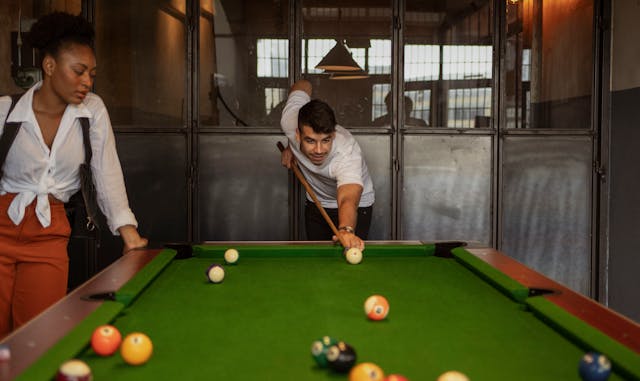Whether you’re a casual player at the local club or a seasoned competitor, you’ll know that a pool cue isn’t just a stick of wood—it’s the extension of your arm, the fine tool that translates intention into precision. While most players understand the importance of practice and focus, fewer realise the secret edge often lies in the cue itself. Selecting, maintaining, and mastering the right cue can take your game from average to sharp in no time.
This article breaks down the essentials of how the right cue can transform your performance, offering practical tips, expert-backed guidance, and real-world examples that you can apply immediately.
Why Your Cue Matters More Than You Think
It’s easy to underestimate the role of the cue. Many beginners simply pick up whatever is available, assuming all cues are more or less the same. But the truth is, professional players invest heavily in their equipment because subtle differences in balance, weight, and tip quality can drastically change the outcome of a shot.
Think of it like cricket bats or golf clubs—yes, skill is king, but the right gear gives you consistency and control. A cue fine-tuned to your style allows you to:
- Deliver smoother strokes
- Reduce unwanted deflection
- Control spin with accuracy
- Improve long-term consistency
The Key Elements That Give a Cue Its Secret Edge
1. Cue Weight and Balance
The weight of your cue (typically 18–21 ounces) determines how it feels in your hand. Some players prefer a heavier cue for more powerful breaks, while others lean towards a lighter cue for finesse shots. The balance point—the spot where the cue naturally balances on your hand—also affects control.
Pro tip: Experiment with cues of different weights and notice how your stroke flow changes. Most advanced players settle into a weight that feels like a natural extension of their arm.
2. Shaft Material and Flexibility
Cues are crafted from materials like maple or ash, each with unique qualities. Maple shafts, for instance, offer a solid, smooth hit, while ash has a visible grain that helps with alignment. Some modern cues also use low-deflection shafts designed to reduce cue ball squirt when applying spin.
This technology isn’t just for professionals—it can significantly shorten your learning curve.
3. The Cue Tip: Small Part, Big Impact
The tip of your cue is arguably the most critical component. Soft tips grip the cue ball more effectively, giving you enhanced spin control, but they require more maintenance. Hard tips, on the other hand, last longer but provide less spin.
Regular shaping and chalking of the tip ensure consistent contact. Neglecting this tiny piece of leather could cost you crucial shots.
4. Grip and Wrap
From Irish linen to leather wraps, the grip on your cue determines comfort and stability. Sweaty palms during a tense game? A wrap that absorbs moisture can make a difference. If you prefer a slicker feel, a wrapless cue might be your best bet.
How to Choose the Right Cue for You
Selecting a cue doesn’t need to feel overwhelming. Here’s a simple checklist you can use when testing one:
✔ Check the straightness of the cue by rolling it on the table ✔ Test the balance by holding it in the centre ✔ Try a few shots to see how the weight feels in your stroke ✔ Inspect the tip condition—soft, medium, or hard ✔ Pay attention to how the grip feels in your hands
Tip: Visit reputable cue stores (example here) where you can actually test cues and get advice from experts instead of guessing online.
Practical Steps to Maintain Your Cue’s Edge
Even the best cue loses its magic if not cared for. Here are some quick habits to keep your cue in prime condition:
- Clean the shaft regularly: Use a cue cleaner or a soft cloth to prevent dirt buildup.
- Keep it straight: Store cues upright in a case, away from heat or damp.
- Maintain the tip: Shape, scuff, and replace as needed.
- Use quality chalk: Cheaper chalk wears unevenly and can damage your tip.
- Protect your investment: Always transport in a padded cue case.
Frequently Asked Questions
Do I need an expensive cue to play better?
Not necessarily. A well-balanced, mid-range cue often gives beginners the biggest boost. Expensive cues are more about fine-tuning and personal preference.
How often should I replace my cue tip?
Depending on usage, a tip can last anywhere from 6 months to 2 years. Replace it when it becomes too flat, hard, or unresponsive.
Is a break cue really necessary?
If you play regularly, yes. A dedicated break cue with a harder tip and stronger build protects your playing cue and delivers more power on the break.
Can I customise my cue?
Absolutely. From personalised wraps to engraved designs, cues can reflect your personality while also improving grip and comfort.
Conclusion:
At the end of the day, pool isn’t just about who practices more—it’s about who plays smarter. The right cue acts as your secret edge, sharpening your accuracy, boosting your confidence, and unlocking the potential you already have within.
Don’t leave your game to chance with whatever cue is lying around. Take the time to explore, test, and invest in one that feels right for you. Whether you’re just starting or aiming to compete at higher levels, your cue might just be the missing link between average and extraordinary play.








Leave a Reply